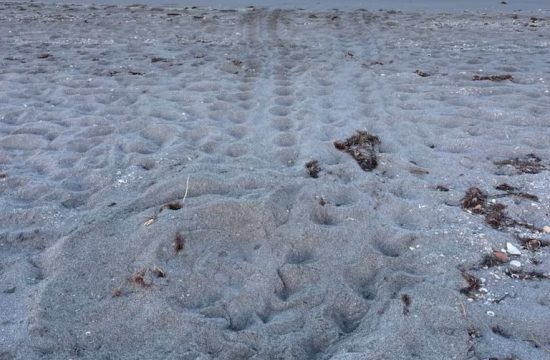Sarasota’s Hidden Connections to the Civil War
“My family and I recently took a min-vacation in Sarasota, Florida. The sunshine and clear blue waters were a welcome break from the bleak and cold weather back in Washington. Sarasota is known for gorgeous Gulf Coast beaches, luxury hotels, and charming St. Armands Circle. This is probably the one of last places that would come to mind when thinking about Civil War history. However, given the city’s location along the Florida coast (think Union blockade), I knew there had to be something that would appeal to my curiosity. In the end, I found plenty of interesting connections to the war. Most of the Civil War-related historic sites are long gone, although one marker, in particular, tells the captivating story of a Confederate Cabinet member’s escape from the United States.
A view of the Gulf of Mexico from the beach on Lido Key, Sarasota
Sarasota and the surrounding region were settled in the decades prior to the Civil War. William Whitaker, a Georgia native and veteran of the Second Seminole War, is considered Sarasota’s first permanent white settler. He profited from a Federal homesteading law known as the Armed Occupation Act, which promised up to 160 acres of land in Florida to any head of household who cultivated at least five acres and lived there for five years. Arriving in 1842, Whitaker built a cabin at Yellow Bluffs along Sarasota Bay. He started as a fisherman and later turned to cattle ranching and citrus farming. Seminole Indians burned Whitaker’s home in the late 1850s, but he remained and re-built near present-day 12th Street and Tamiami Trail (U.S. 41). Two historical markers commemorate Whitaker’s role in the establishment of Sarasota. (See here and here.)
William Whitaker, shortly after the Civil War (courtesy of Wikipedia)
On the eve of the Civil War, slaves comprised around 44 percent of Florida’s population of just over 140,000. In Manatee County, where Sarasota was then located, 30 percent of the inhabitants, or 253 out of 854 persons, were listed as slaves in the 1860 Census. Whitaker himself owned a handful of slaves, including a runaway from North Carolina whom he had found and purchased in 1857.
Florida was an early and strong supporter of secession. Only a few weeks after Abraham Lincoln’s election, the state’s governor signed legislation calling for a convention to consider the question of secession. On January 10, 1861, the delegates adopted an Ordinance of Secession by a vote of 62 to 7. Florida was the third state to leave the Union after South Carolina and Mississippi.
Following the outbreak of war in April 1861, the Union imposed a naval blockade on the Confederacy. Federal vessels patrolled Florida’s extensive coastline in an effort to stop trade. As the noose tightened, the Sarasota region experienced a shortage of goods, but resourceful locals found ways to deal with the resulting hardship. Whitaker, for instance, traveled all the way to Gainesville to buy grain for use in area gristmills.
Union raiding parties sometimes landed along the coast in search of supplies. They took garden vegetables, citrus fruits, cows, and chickens from the settlers. Whitaker, who sold cattle to the Confederate Army, maintained his herd in the eastern part of Manatee County and away from Union hands. Incidentally, Florida contributed a substantial number of cattle to the Confederacy, and authorities established the so-called “Cow Cavalry” in south Florida to prevent Union raiders from seizing livestock.
This engraving from the November 15, 1862 edition of Harper’s Weekly depicts a Union movement against a large salt factory on the north Gulf Coast of Florida (courtesy of soneofthesouth.net).
Florida also became a key supplier of salt to the Confederate war effort. Salt was made by evaporating sea water, mainly through boiling. Union expeditions aimed to disable the salt works along the Gulf Coast. Whitaker was involved with salt production, but unlike others, his own works escaped harm.
Judah P. Benjamin (courtesy of Wikipedia). Benjamin was one of the most prominent American Jews of the 19th century.
Sarasota’s most fascinating connection to the Civil War actually came after hostilities had ended. Judah P. Benjamin, a former U.S. Senator from Louisiana, served as the Confederate Attorney General, Secretary of War, and Secretary of State. When Richmond fell in April 1865, he fled to the Deep South with President Jefferson Davis and the Confederate Cabinet. Benjamin left Davis in Georgia and headed to Florida, where he intended to slip out of the country. Fearing arrest for treason, Benjamin disguised himself as a farmer looking to purchase land in Florida. Confederate sympathizers assisted Benjamin as he made his way through the state. One stay included the Gamble Mansion in Ellenton. Finally, Benjamin arranged for Capt. Frederick Tresca to take him to the Bahamas aboard a sixteen-foot sloop. Tresca hid the small boat in Whitaker Bayou in Sarasota. Meanwhile, the former Confederate Secretary of State was smuggled to Whitaker’s home in a wagon filled with fresh beef. On June 23, 1865, Benjamin finally set sail with Tresca and reached Bimini on July 10. Benjamin eventually traveled to England, where he rose to prominence as a barrister.
The antebellum Gamble Mansion in Ellenton, Florida, not far from Sarasota (courtesy of Gamble Plantation Historic State Park). Built between 1845 and 1850, the mansion is considered the only surviving plantation house in South Florida. Maj. Robert Gamble cultivated sugar here until the late 1850s. The mansion is now part of a state park. I didn’t have an opportunity to visit during my trip to Florida, but hope to get there the next time around. For information about touring the Gamble Mansion, see here.
In the early 1940s, the United Daughters of the Confederacy led an effort to erect a marker in Sarasota to commemorate Benjamin’s escape. On January 22, 1942, the new marker was unveiled with great pomp and circumstance, including a parade, patriotic music, a luncheon at the John Ringling Hotel, and a program at the Municipal Auditorium. Florida Governor Spessard L. Holland, Congressman J. Hardin Peterson, and Sarasota Mayor E.A. Smith delivered remarks.
The original Judah P. Benjamin marker is located at a pull-off on the corner of 10th Street and U.S. 41, not far from the Sarasota County Visitor Information Center. Dedicated in 1942, the marker is made of pink Georgia marble.
A second marker dedicated to Judah P. Benjamin and his escape at Sarasota Bay. It is located next to the original marker (above). For more information, see here.
The reverse side of the above historical marker.
A view of Yellow Bluffs along Sarasota Bay. Benjamin set out from these waters on June 23, 1865.
My trip to Sarasota proved once again that the Civil War is never far from the surface in this country. If you look hard enough, you can usually find a connection, even in paradise. I haven’t much considered Florida’s role in the Civil War, so I welcomed the opportunity to learn more. Now if I can only convince my family to take a trip to Olustee!”
Sources
Pierce Butler, Judah P. Benjamin (1907); David J. Coles & Richard J. Ferry, “The Smallest Tadpole,” Florida in the Civil War (from Florida Memory); Florida Center for Instructional Technology, College of Education, University of South Florida, “Florida’s Role in the Civil War: ‘Supplier of the Confederacy,'” Exploring Florida; Florida Department of State, Florida in the Civil War: 1861-1865; History of Sarasota Country (website); Jeff Lahurd, “Civil War leader escaped through Sarasota,” Sarasota Herald-Tribune, June 26, 2011; Ann Shank, “Florida Joined Union in 1845 as a Slave State,” Journals of Yesteryear (Sarasota History Alive!); Ann Shank, “Sarasota Bay During the Civil War,” Journals of Yesteryear (Sarasota History Alive!); Mark D. Smith, “Creation of the Judah P. Benjamin Memorial,” Journals of Yesteryear (Sarasota History Alive!); U.S. Census Bureau, Census of Population and Housing, 1860; “William Whitaker (pioneer),” Wikipedia.













